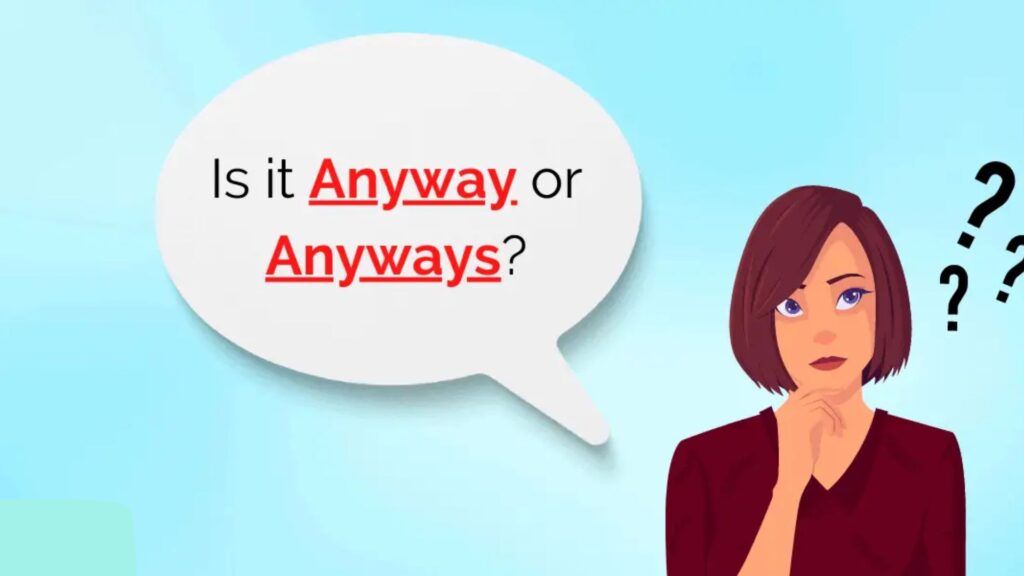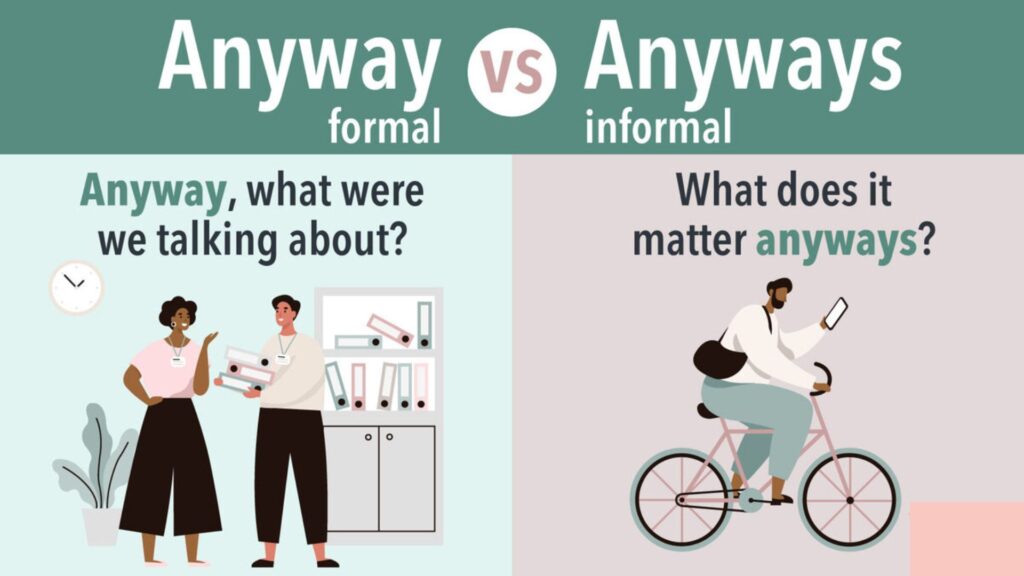Navigating the nuances of the English language can sometimes feel like walking through a maze. One common confusion arises between the words “anyway” and “anyways.” While they seem similar, understanding when to use each can enhance your writing and communication. Let’s dive into their meanings, differences, and practical usage in everyday scenarios.
Understanding the Basics
What Does “Anyway” Mean?

“Anyway” is an adverb that often signals a transition in conversation or thought. It can imply a return to a previous topic or indicate that something is happening despite other factors. For example, if you’re summarizing your thoughts, you might say, “Anyway, let’s get back to the main topic.”
What About “Anyways”?
“Anyways” is a nonstandard variant of “anyway.” While many people use it in casual conversation, it’s generally considered informal and less accepted in formal writing. In fact, many style guides, including the Chicago Manual of Style, recommend sticking with “anyway.”
When to Use “Anyway”
In Casual Conversations
In everyday speech, “anyway” works well to shift topics or dismiss previous points. Imagine you’re chatting with a friend about weekend plans:
Scenario:
You and your friend, Sarah, are discussing various events.
You: “I thought about going to the concert, but the tickets are sold out. Anyway, what do you think about that new café opening downtown?”
Here, “anyway” effectively redirects the conversation while maintaining a friendly tone.
In Emails
When crafting an email, using “anyway” can help you transition between ideas smoothly. Here’s an example:
Email Example:
Subject: Project Update
Hi John,
I hope this message finds you well. I wanted to update you on our project timeline. We encountered a few delays due to the supplier issues. Anyway, I believe we can still meet our deadline with some adjustments. Let’s discuss this further in our meeting next week.
Best,
Emily
In this email, “anyway” serves to pivot the conversation while maintaining a professional demeanor.
When to Use “Anyways”
In Informal Speech
“Anyways” often pops up in casual conversations, especially among friends or peers. Here’s an example:
Scenario:
You’re catching up with your old college buddy, Mike.
You: “I was thinking about that hilarious party last year. Anyways, do you remember the dance-off we had? That was epic!”
In this context, “anyways” feels natural and light-hearted, fitting the informal setting.
In Text Messages
Texting often embraces casual language, including “anyways.” Here’s a text exchange:
Text Example:
You: “Hey Lisa, I can’t make it to the movie tonight. Anyways, let me know how it goes!”
In this case, “anyways” conveys a laid-back tone appropriate for texting.
The Key Differences

Formal vs. Informal Usage
As mentioned earlier, “anyway” is more widely accepted in formal writing, while “anyways” is reserved for informal contexts. For example, if you’re writing a research paper, stick with “anyway”:
Incorrect: “The results were inconclusive, anyways we will continue our study.”
Correct: “The results were inconclusive; anyway, we will continue our study.”
Regional Variations
Interestingly, “anyways” is more common in certain dialects, particularly in North America. Some may find it more acceptable in spoken language, while others might raise an eyebrow. Always consider your audience.
Practical Scenarios
In Business Communication
When writing to colleagues or clients, it’s crucial to maintain professionalism. Use “anyway” to keep the tone respectful:
Email Example:
Subject: Meeting Reschedule
Hi Mark,
I wanted to let you know that our meeting has been rescheduled to next Friday. Anyway, I look forward to discussing the new project details then.
In this instance, “anyway” keeps the communication clear and professional.
In Social Media Posts
Social media often blurs the line between formal and informal language. Depending on your audience, you can use either term:
Social Media Example:
Post: “Had a great time at the beach today! Anyway, I’m ready for the weekend!”
Here, “anyway” works well to transition to the next thought.
Avoiding Common Mistakes

Misusing “Anyways” in Formal Writing
Many people slip up by using “anyways” in formal contexts. Here’s a quick rule of thumb: if you’re unsure, opt for “anyway.”
Example:
Incorrect: “The project was a success, anyways we need to look at the feedback.”
Correct: “The project was a success; anyway, we need to look at the feedback.”
Overusing Transition Words
While “anyway” can be a helpful transition, avoid overusing it. Relying on it too much can make your writing feel repetitive. Instead, mix it up with phrases like “in addition,” “furthermore,” or “regardless.”
Conclusion
Understanding how to use “anyway” and “anyways” enhances your communication skills. While “anyway” is the preferred choice in formal writing, “anyways” can add a casual touch to informal conversations. Remember to consider your audience and context when choosing between the two.
By keeping these guidelines in mind and practicing in various scenarios, you’ll master the art of using “anyway” and “anyways” effectively. So, the next time you find yourself in a conversation or writing an email, you’ll know just which word to choose!

